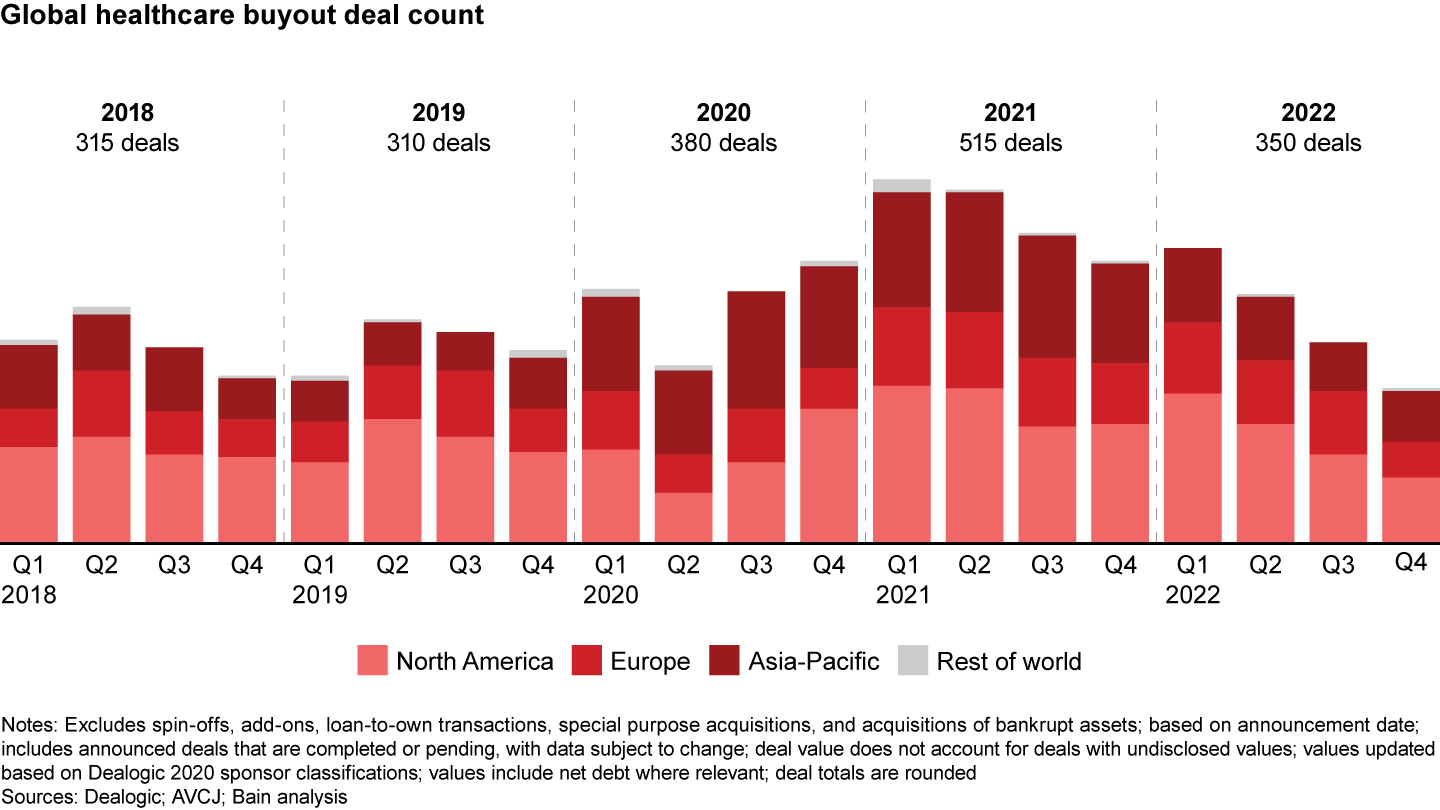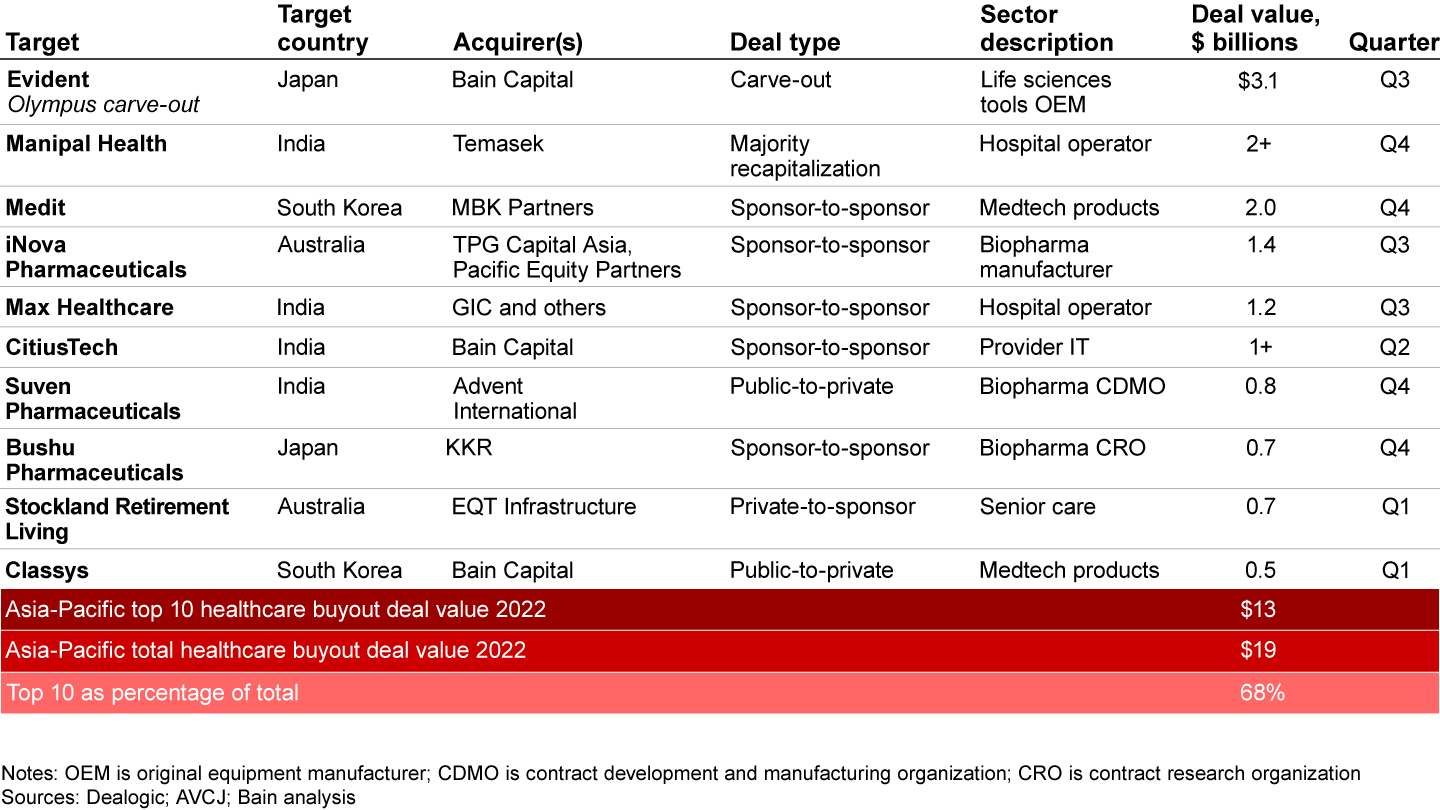Global Healthcare Private Equity Report

At a Glance
- Signs of strength in Asia-Pacific: Total disclosed deal value maintained 2021’s record pace, with six deals in excess of $1 billion, five of them from the second half.
- While deal count fell from its 2021 high due to evolving market dynamics in China, Asia-Pacific—outside of China—had its best year yet in terms of deal count.
- Provider sector activity remained resilient thanks in part to the burgeoning deal market in India, while dealmaking in biopharma and medtech was more constrained.
- Looking ahead, we expect investor interest in Asia-Pacific healthcare private equity to stay strong as an emerging pool of investable assets will continue to draw interest from large funds.
This article is part of Bain's 2023 Global Healthcare Private Equity and M&A Report.
Private equity investments in the Asia-Pacific region continued their strong multiyear growth trajectory in 2022. Total disclosed deal value reached over $19 billion for the year, surpassing the previous year’s record. Large deals in Japan, India, South Korea, and Australia accounted for the majority of 2022 Asia-Pacific deal value, including six buyouts valued over $1 billion. Seven of the 10 largest deals were announced in the second half of the year, defying the “tale of two halves” narrative seen in North America and Europe (see Figure 1).


India in particular had an impressive year. Buyouts for assets based in India accounted for 4 of the 10 top deals (see Figure 2). This strong regional activity is a testament to these markets coming of age with geographical breadth, opportunities across sectors, and, on average, check sizes continuing to grow.


Time will tell if 2022’s busy second half is a sign of more to come in 2023. The record number of $1 billion buyouts in Asia-Pacific could be attributable to several factors. Dry powder continues to stand high, and there is meaningful demand for the underlying healthcare services across industry cycles. Five of the top 10 deals were sponsor-to-sponsor transactions, and these large trades between sponsors demonstrate the region’s maturity and attraction to global megacap funds.
Outside of China, Asia-Pacific had its best year yet in terms of deal count and disclosed value
While 2022 generated impressive value numbers, total Asia-Pacific healthcare private equity deal count slowed in 2022 compared with prior years. The region also lost ground in terms of global share of buyout volume. Deal volume in Asia-Pacific reached 35% to 40% of global activity in 2020 and 2021, but was only around 25% of global volume in 2022.
Evolving market dynamics in China decreased regional deal activity. The series of lockdowns driven by the country’s zero-Covid policy and general geopolitical uncertainty led investors to sit on the sidelines. Slowing growth, evolving policy (including volume-based procurement for medtech devices), and a growing desire for pharma and medtech manufacturers to diversify supply chains played a role in China’s 2022 market dynamics. The biopharma and related services sector, traditionally a major driver of buyout activity across the region, saw much lower deal volume in 2022 than the previous two years.
As a result of these trends, total annual deal value in China dropped from an average of around $5.3 billion across 2017–21, to $1.6 billion in 2022. Deal count in 2022 dropped by 67% from the 2017–21 average (see Figure 3). Additionally, China’s share of regional buyout deal value declined from an average of around 35% to 40% over the past 10 years, to about 7%–10% in 2022.


While total Asia-Pacific deal count was down for the year, outside of China the region had its best year ever in terms of deal count and disclosed value. This was driven mostly by activity in the provider sector.
Provider sector activity remained resilient, while medtech and biopharma activity were more constrained
Activity in the provider sector proved resilient in 2022, nearly matching 2021 in terms of deal volume. Notably, the sector occupied around 23%–24% of deal volume share in 2020 and 2021 but surpassed 40% of deal volume share in 2022. India saw a particularly busy year for provider deals as demand for more accessible, high-quality care drove growth. Eleven of the 38 Asia-Pacific provider deals were for providers in India, the most of any country in the region. This activity was punctuated by two deals valued over $1 billion—both of which evidenced a trend of continued consolidation and expansion of traditional multispecialty hospitals. In the third quarter, GIC announced plans to acquire KKR’s entire stake in Max Healthcare for roughly $1.2 billion. Late in the year, Temasek announced plans to raise its stake in Manipal Health to a majority share by buying out TPG and other privately held shares.
Outside of India, there is a continued interest in specialty models. In Australia, Adamantem Capital invested to demerge CardioCo from KKR-backed GenesisCare, leaving GenesisCare to focus on oncology services. Additionally, we are seeing a trend of sponsors supporting digital health natives to expand offline through the acquisition of physical sites of care. In Singapore, a regional healthcare tech company called Doctor Anywhere (backed by Novo Holdings, Kamet Capital, and others) has already acquired Catalist-listed Asian Healthcare Specialists, an integrated healthcare provider in Singapore.
In contrast, biopharma deal volume was down in Asia-Pacific in 2022. The pullback was largely tied to market dynamics in China. Outside of China, biopharma deal activity persevered, and was responsible for 3 of the top 10 largest deals in the sector. Private equity investments in biopharma continue to focus on services and contract development. PAG, Samara Capital, and CX Partners acquired Optimus Group, which provides manufacturing, fabrication, and processing services for drugs. Hillhouse acquired George Clinical, which offers a full range of clinical trial services to biopharmaceutical customers. Advent International acquired Avra Laboratories as part of their larger strategy to build out an active pharmaceutical ingredients and contract development and manufacturing organization (CDMO) platform.
Businesses that participated in the medtech and life sciences tools sectors faced continuing supply chain issues. For medtech and life sciences tools original equipment manufacturers, persistent global commodity shortfalls made manufacturing difficult, and capital expenditure purchase cycles became longer due to limited availability of government funding. However, outside of China, buyout deal activity in both of these sectors improved in relation to 2021 numbers. Also, while activity was down, overall value for the medtech sector was up in relation to 2021, mostly due to the purchase of two large South Korean assets: MBK Partners purchased Medit for approximately $2 billion, and Bain Capital purchased Classys for more than $500 million. This marks the first time since 2019 that a medtech deal has made the top 10 deals list for the region.
An emerging pool of investable assets will draw interest from large funds
There are several reasons to remain optimistic in 2023, even with uncertainty still swirling in deal markets. Asia-Pacific-specific fund-raising is up, dry powder remains ample, and M&A in healthcare has created more large-cap targets. Several firms recently raised or are currently raising $1 billion-plus Asia-Pacific-specific funds that list healthcare as an explicit area of focus. These include Qiming Venture Partners Fund VIII ($2.5 billion) and Vivo Capital’s RMB-denominated fund (targeting $1.5 billion). Healthcare-focused OrbiMed is also seeking $4.75 billion across three new funds that feature Asia-specific investment vehicles, and Quadria Capital may be raising close to $1 billion for its third healthcare-focused investment fund, betting on “market opportunities in Asia” as a vehicle for fund size growth.
Additionally, there is an emerging pool of investable assets in Asia-Pacific, which could make 2023 an exciting year. Portfolio companies continue to resurface in the market, driving up deal value. Of the buyout deals that were $500 million-plus in 2018–19, more than 10 have yet to retransact. These assets are likely to return to market in the coming years, creating potential for private equity investors to step in.
Finally, India and Southeast Asia continue to be markets to watch. In both regions, investors are likely to continue to bet on the large unmet healthcare need supporting the hospital sector. India will probably also see increased investments in pharma services and the application programming interface/CDMO space as global biopharma companies diversify their supply chains beyond China.